Tomasz Lis | November 2020 | London
Caravaggio painted Musicians for his first powerful patron, Cardinal Francesco Maria del Monte. Del Monte was a man of power, wealth and influence, as well as being a great patron of arts and interested in music, poetry and alchemy. The canvas, one of the first of Caravaggio’s multi-figured compositions, presents three scantily dressed, dreamy-eyed, open-mouthed youths playing instruments. In fact, one is tuning his lute, while the remaining two either hold a music score or are getting ready to play a horn. There is a slight sexual undertone to the way they present themselves and a certain element of staged theatricality. We know that Cardinal Francesco owned a collection of instruments and the painting may have partly served the purpose of showing this off. And yet, in the left-hand corner of the canvas there appears a Cupid, helping himself to a bunch of juicy-looking grapes. Suddenly this marvellous winged creature unites music and love, in the perfect harmony for which they strive. Sadly, the musical notes are unintelligible due to the deteriorating state of the canvas in precisely those places. Perhaps the music would give another layer to our understanding of the scene if indeed the painter intended so.
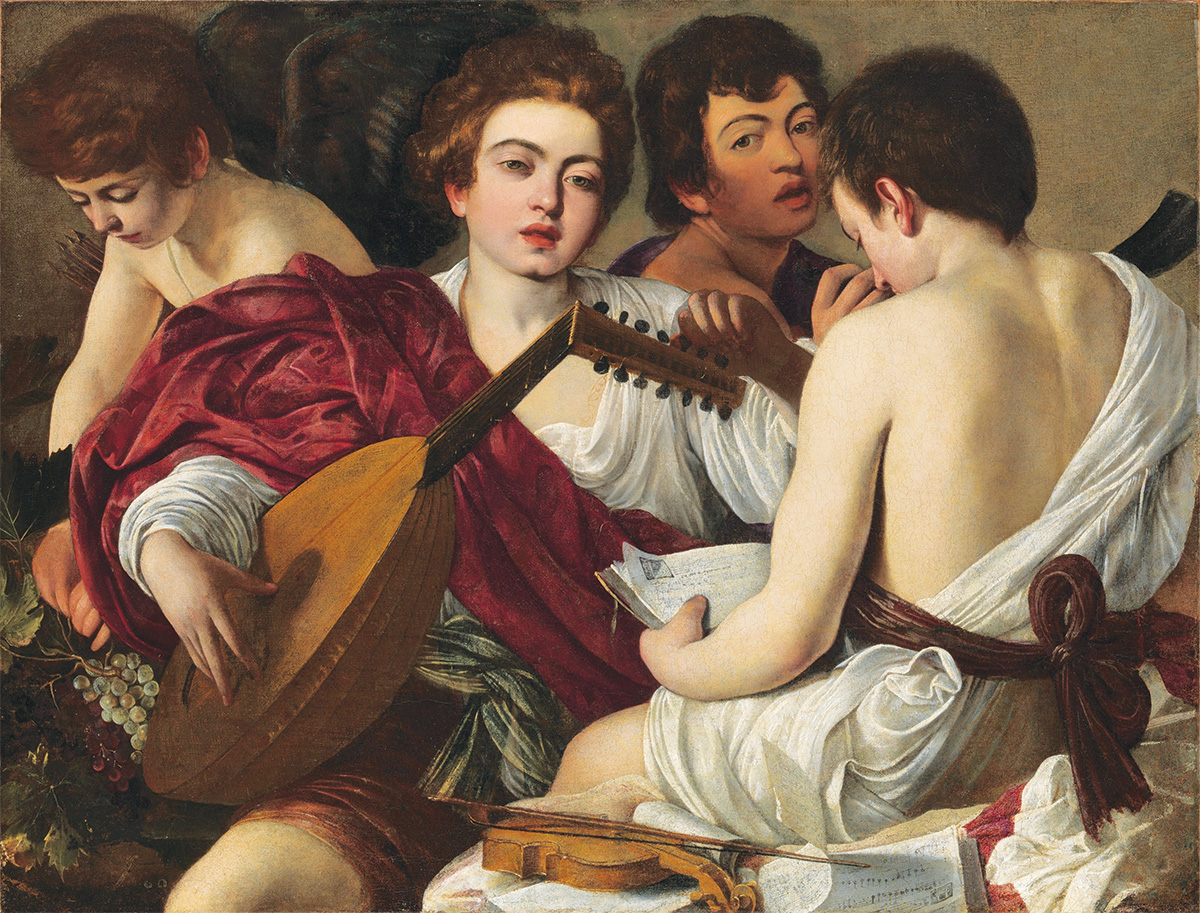
Musicians by Caravaggio – Metropolitan Museum of Art, Public Domain.
This he clearly did in his Rest on the Flight to Egypt, finished two years later and now hanging at the Galleria Doria Pamphilj in Rome. This fascinating painting is one of a kind, precisely because of the music being played by the angel, with Joseph holding the score. It’s an unprecedented concept invented entirely by Caravaggio and not mentioned in the Bible. The heavenly musician takes centre stage, playing a Marian motet from the Song of Solomon: ‘Quam pulchra es et quam decora’ by the Franco-Flemish composer Noël Bauldewijn. The very popular notion of a dialogue between lover and beloved was often applied to Christ and the Virgin Mary and continued all the way to the baroque era. Johann Sebastian Bach used the allegory in his cantata BWV 49 ‘Ich geh und suche mit Verlangen’ (‘I go and seek with longing’). The divinely peaceful and tender embrace of mother and child becomes both real and symbolic.
This he clearly did in his Rest on the Flight to Egypt, finished two years later and now hanging at the Galleria Doria Pamphilj in Rome. This fascinating painting is one of a kind, precisely because of the music being played by the angel, with Joseph holding the score. It’s an unprecedented concept invented entirely by Caravaggio and not mentioned in the Bible. The heavenly musician takes centre stage, playing a Marian motet from the Song of Solomon: ‘Quam pulchra es et quam decora’ by the Franco-Flemish composer Noël Bauldewijn. The very popular notion of a dialogue between lover and beloved was often applied to Christ and the Virgin Mary and continued all the way to the baroque era. Johann Sebastian Bach used the allegory in his cantata BWV 49 ‘Ich geh und suche mit Verlangen’ (‘I go and seek with longing’). The divinely peaceful and tender embrace of mother and child becomes both real and symbolic.
Music and painting were for centuries the domain of the educated elite, first royalty and aristocracy and later the affluent middle class. They functioned as an intellectual and sensual nourishment, a source of pleasure and ambition, and finally a tool of political and religious thought and propaganda. Musicians were not always sufficiently appreciated and, prior to the invention of recording, music by its nature was entirely ephemeral. It was rare to hear the same piece performed twice and very little found its way into print. A painting was there to stay and, if it were lucky enough to escape the ravages of war or natural disasters, it could survive for centuries.
Demand for great art never ceased but, while music was always present, composers had to work hard to earn their recognition. While it was not unheard of for a painter or sculptor to join the ranks of the ruling classes and to be treated on almost equal terms, musicians were often left behind. Claudio Monteverdi, arguably the greatest early-baroque master, spent his entire career working for one of the most sophisticated and art-hungry patrons. And yet, the Gonzaga family, famous for their lavish support of the arts, exceptional taste and superb education, were equally lousy with payments, which were often late and insufficient. It was only when he reached Venice and became Maestro di Capella of the Basilica di San Marco, that he found professional and financial stability and a rightful place among the city’s elite.
Italy has always been the beacon of artistic excellence and its mighty cities provided all the necessary tools for it to flourish. When Monteverdi moved to Venice, La Serenissima’s political weight was starting to fade but its cultural relevance grew even stronger. It’s as if, after years of hard work, its citizens decided to spend their wealth on beauty, art and pleasure.
When the Benedictine monks commissioned Paolo Veronese to fill their new refectory, their measurements were very specific – ‘a painting as wide and as high as the wall’ – but whether they expected it to be so lavish is another matter. Considering most of the monks were the younger sons of the Republic’s patrician families, such an opulent feast would not surprise them. In fact, they were not even allowed to raise their eyes from the plates when eating.
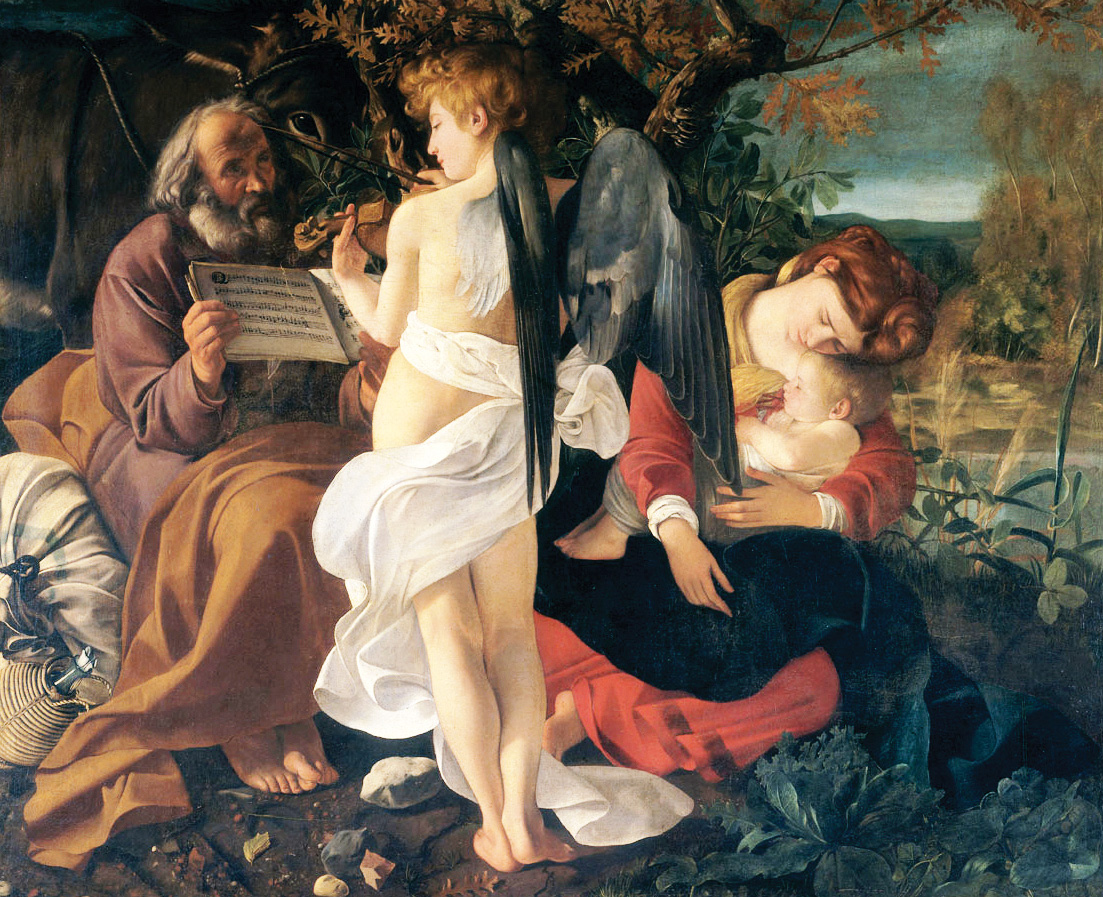
Rest on the Flight to Egypt by Michelangelo Merisi da Caravaggio – The Yorck Project (2002) 10.000 Meisterwerke der Malerei (DVD-ROM), distributed by DIRECTMEDIA Publishing GmbH. ISBN: 3936122202., Public Domain.
Italy has always been the beacon of artistic excellence and its mighty cities provided all the necessary tools for it to flourish. When Monteverdi moved to Venice, La Serenissima’s political weight was starting to fade but its cultural relevance grew even stronger. It’s as if, after years of hard work, its citizens decided to spend their wealth on beauty, art and pleasure.
When the Benedictine monks commissioned Paolo Veronese to fill their new refectory, their measurements were very specific – ‘a painting as wide and as high as the wall’ – but whether they expected it to be so lavish is another matter. Considering most of the monks were the younger sons of the Republic’s patrician families, such an opulent feast would not surprise them. In fact, they were not even allowed to raise their eyes from the plates when eating.
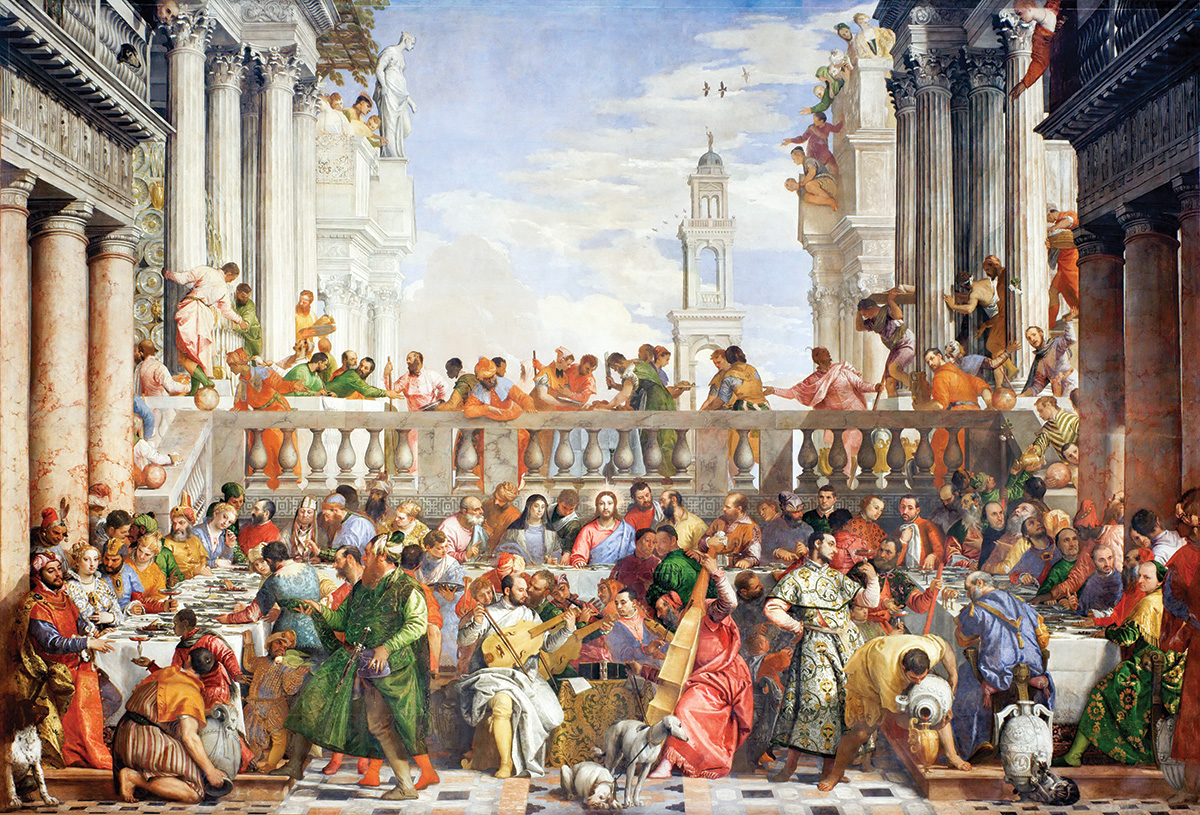
The Wedding at Cana by Paolo Veronese, Public Domain.
The painting, stolen from San Giorgio by Napoleon and never returned, is one of the largest works on canvas ever painted, and though The Marriage at Cana speaks of Christ turning water into wine, you would be forgiven for not seeing much water but plenty of wine.
Among its many fascinating details are three ‘musicians’ sitting right at front of the table where Christ presides, quietly oblivious to all the hustle and bustle around him. If the legend is true, those three gentlemen playing cello, double-bass and violin are Veronese himself, Titian and Tintoretto, the three undisputed masters of 16th-century Venetian painting. What music they are playing we cannot be sure. Perhaps a piece by Andrea Gabrieli, the leading composer of the time, under whose command the music at San Marco reached great levels of excellence. His music adorned many such splendid feasts, including those celebrating victory at the Battle of Lepanto and the embassy of princes from Japan. Titian, the most famous of all Venetians painters, owned an organ and may have played it when meeting friends for dinner. Perhaps this remarkable symbiosis of all art forms and search for perfect harmony of colour and proportion in painting, music and architecture could only happen in a city whose own existence was a miracle itself.
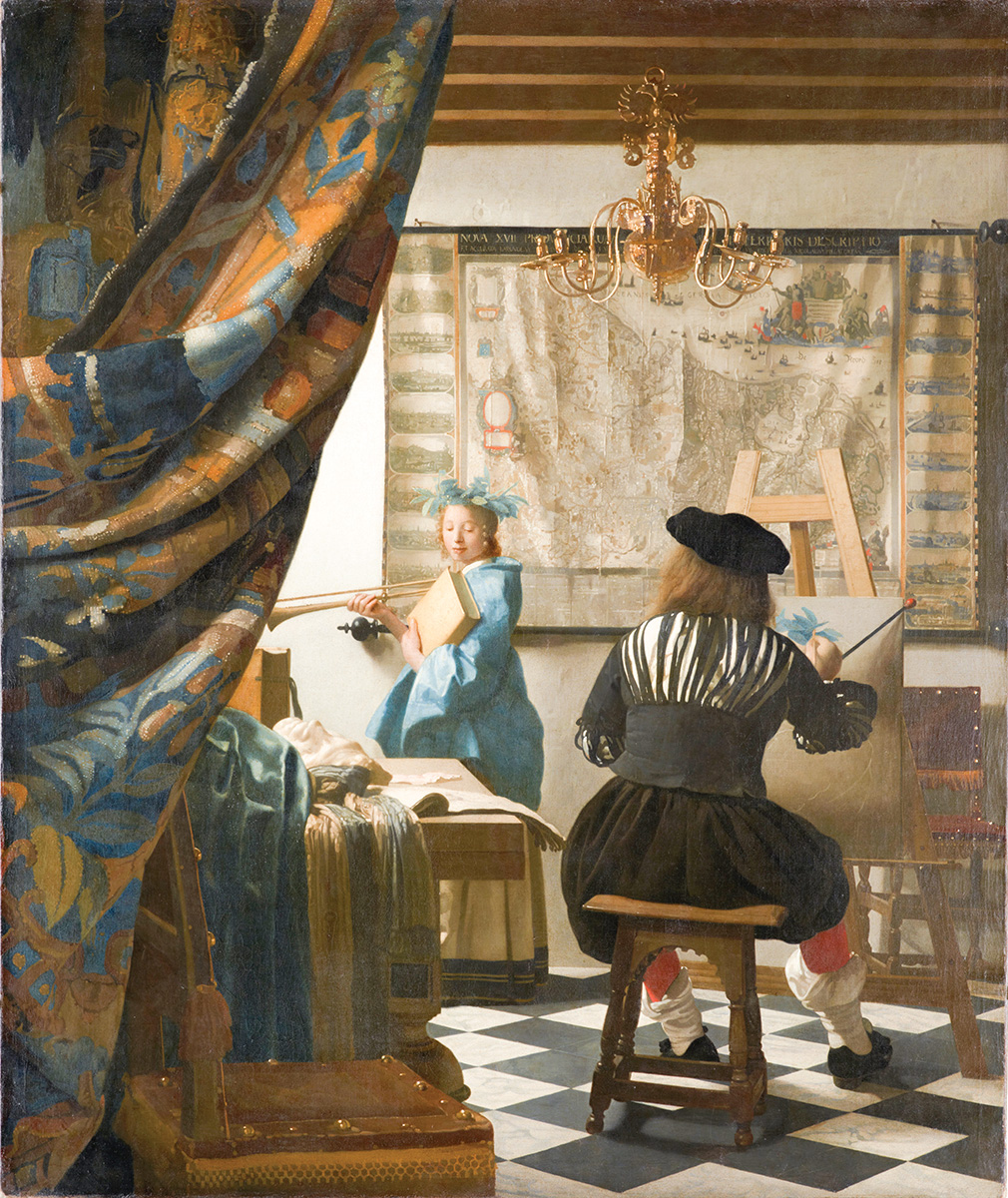
The Art of Painting by Johannes Vermeer – lAHeqBoLaePtEA at Google Cultural Institute maximum zoom level, Public Domain.
When Dutch masters painted music it usually symbolised love and the art of seduction. Sometimes it is blatantly obvious that checking correct fingering is not a teacher’s only interest and his intentions towards his student are of a more flirtatious nature. Of all Vermeer’s paintings, eight consist of musical references, mostly presenting young women playing instruments or having lessons, but their meaning is often less straightforward and more mysterious than with painters such as Steen, Van Mieris or Metsu. Perhaps the best example would be The Art of Painting, where the young woman wearing a laurel wreath and holding a trumpet does not refer to music at all but is in fact Clio, the Muse of History, and the trumpet may suggest heroic deeds and victories. Music can also be your life companion and a cure for troubled soul if we follow the inscription written on a harpsichord lid in the painting titled The Music Lesson: ‘Musica Letitiae Comes Medicina Dolorum’.
For Frederic the Great, King of Prussia, music was indeed a life companion. He was not averse to heroic deeds either. One wonders what he thought of Dutch art if he actually looked at any during his incognito visit to Amsterdam. One anecdote says he pretended to be a flautist when visiting an inn but the landlady thought him to be too shabby-looking to settle his bill. His companions assured her of their friend’s remarkable talents and that he could earn more money in an hour than ten vol-au-vents would cost. When he played, leaving her entranced, she promised to bake the meal without further ado. Adolph Menzel’s The Flute Concert of Frederick the Great at Sanssouci is possibly more famous for its subject than its execution. Its magically lit atmosphere of that jewelled music room at Sanssouci is as alluring and fascinating as the scene itself. Frederic was a complex and complicated human being: enlightened, tyrannical and highly educated, and equally narrow-minded, sophisticated and cruel. In short, he was man of extraordinary contradictions. His thirst for a great and powerful Prussia contrasted with his total distaste of German language and insatiable appetite for everything French. The King loved music but his tastes were very much like his gorgeous palace: très rococo. His court orchestra was one of the best in Europe but, apart from Quantz, none of them was properly paid. Carl Philip Emmanuel Bach, accompanying the monarch at the harpsichord, spent 28 years in Potsdam before running away to Hamburg, where his talent was more sufficiently rewarded. His face in the painting reveals more disdain than admiration for his royal master. Frederic did not like women and his private moments of leisure were mostly in the company of his male friends. The presence of ladies in the painting is thus slightly misleading, though he remained very close friends with his sister Wilhelmina, sitting right underneath the chandelier and looking rather pensive. The three gentlemen on the left-hand side of the canvas provide a delightful snapshot of the royal court: the French mathematician and writer Pierre Louis Moreau de Maupertuis, looking up at the ceiling and clearly bored with it all; a plump-looking courtier and a diplomat of no real merit, Count Gustav Adolf von Gotter; and, finally, Baron Jacob Friedrich von Bielfeld, looking enraptured, whose record of one such evening leaves us with no doubt as to his devotion to the King of Prussia: ‘Evenings are devoted to music. The Prince gives regular recitals at his Salon – invitation only, of course, and those who receive an invitation may consider themselves highly favoured. The Prince usually plays the flute. He has perfect command of his instrument: his embouchure, dexterity, fluency and presentation are unique. But then Frederic is accomplished in all things…’
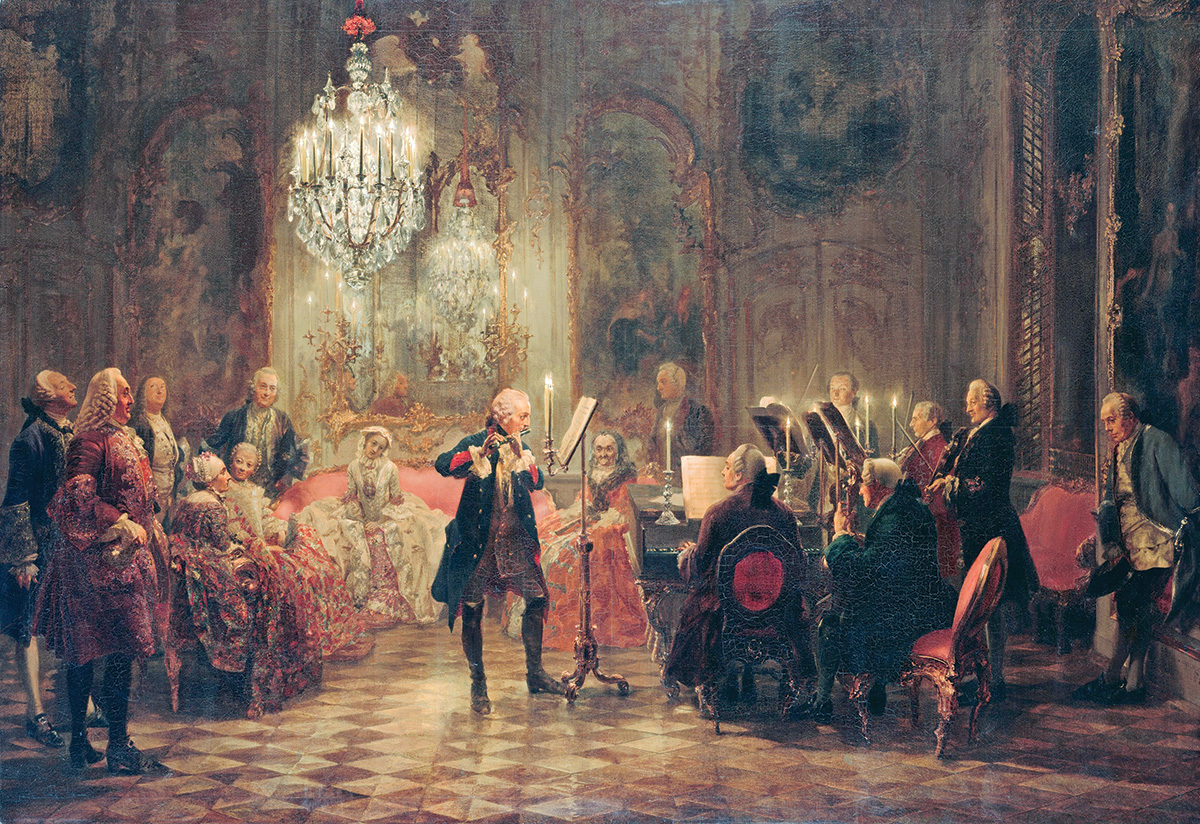
Flute Concert of Frederic the Great at Sanssouci by Adolph von Menzel – WAFEF2zy8Ym8vQ at Google Cultural Institute, zoom level maximum, Public Domain.
Although painting sound is impossible, music found its way into the world of painting with fascinating effects. No art form functions in isolation and such seemingly irreconcilable disciplines cross paths more often than we expect. Discovering these connections is mightily rewarding and inspiring. Remember it next time you visit a museum and look at the paintings with a more inquisitive eye.

